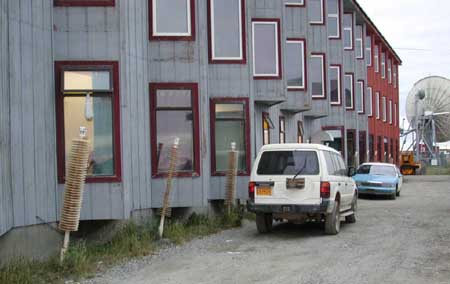 |
| Website Home (Menu del Dia) | ||
| Previous | Alaska Home | Next |
Construction on Permafrost
 |
This is the Nullagvik Hotel, which has somewhat of a monopoly on tourist accommodations in Kotzebue (room rates were about US$195 for those visiting without a tour package, if memory serves, with very basic furnishings and no television, which was rather refreshing). The satellite dish in the background is the AT&T telephone exchange; remember Kotzebue's remoteness, and imagine being the poor technician dispatched to locate and reposition downed telephone poles anchored in the shallow soil above the permafrost back into the frozen ground after being downed by a winter storm in January. Or, imagine being the telecommunications company who had to pay the technician's salary and resolve customer complaints. Maybe using a satellite for all long distance calls isn't such an outrageous idea.
The poles sticking out of the ground along the entire length of the hotel are a common sight in tundra towns. Building on permafrost presents special challenges. First, a building's foundation can't be deeper than the top of the permafrost. Second, the soil above the permafrost is usually one or more of glacial silt, glacial till, peat or marsh, but never bedrock, so building's not only have a shallow foundation, but poor substrate as well. Third, and most significant, heating a building or simply disturbing the ground during construction melts the permafrost and makes the ground unstable so that a building settles unevenly or sinks as the melted permafrost turns the ground into a quicksand-like mush.
So what's a building contractor to do? Enter the poles! The poles are actually pipes with radiator fins and are part of a large network of pipes running underneath the building. The pipes contain anhydrous ammonia, which is a refrigerant and was used in the first commercial refrigerators. Because ammonia is toxic to humans, modern refrigerators and air conditioners use freon as the refrigerant. Anhydrous ammonia is a gas at room temperature, but during the winter when temperatures fall well below zero, the ammonia condenses into a liquid and falls to the bottom of the pipe system next to the permafrost which is cold, but warmer than the boiling point of anhydrous ammonia. This causes the ammonia to return to a gas and cool the permafrost. The anhydrous ammonia gas rises to the top of the pipes where its heat is released into the cold arctic winter through the fins and it re-condenses into a liquid, starting the cycle over again. So the poles pictured above are part of a large cooling system beneath the foundation to keep the permafrost frozen solid and the hotel from sinking into the ground. Expensive? You bet!
| Website Home (Menu del Dia) | ||
| Previous | Alaska Home | Next |